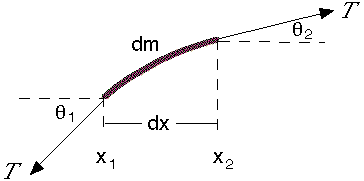How is the wave speed of a string the same as calculating the speed using kinematics?
I know the formula to find it, but I don't understand why it happens.
The formula is #v=sqrt(F_"T"/mu)#
=> where #v# is velocity in #m/s# , #F_"T"# is the tension in the string, and #mu# is the linear density - which is calculated by dividing the mass of the string with its length.
I want to know, how is the velocity calculated by this equation (^) is the same as velocity by kinematics, #v=(Deltad)/(Deltat)# .
How are the answers the same? (because they should be, right?)
Thank you for your time.
I know the formula to find it, but I don't understand why it happens.
The formula is
=> where
I want to know, how is the velocity calculated by this equation (^) is the same as velocity by kinematics,
How are the answers the same? (because they should be, right?)
Thank you for your time.
1 Answer
It can be like this
The speed of the wave is same as the velocity of the wave because standing waves only move in one direction.
To understand this we have to derive
Let’s consider a string that has mass per unit length is μ. It is stretched by a tension T, which is much larger than the weight of the string and its equilibrium position is along the x axis. This diagram shows a short section of the string, stretched in the x direction, and the forces acting on it. Our analysis only applies for small deformations, for which the string is a linear medium, and we neglect the gravitational force on the string (which in any case is constant).

One consequence of this restriction to small deformations is that the angle θ between the string and the x direction is much smaller than 1, so
Let's apply Newton's second law in the vertical y direction:
The sum of forces in the y direction is
Using the small angle approximation, sin θ ≅ tan θ = ∂y/∂x. So we may write:
So the total force depends on the difference in slope between the two ends: if the string were straight, no matter what its slope, the two forces would add up to zero. Now let's get quantitative. The mass per unit length is μ, so its mass
So we can write Newton’s second law in the y direction as

Rearranging this gives

Now we have been using the subscript 1 to identify the position x, and 2 to identify the position

So the acceleration (on the left) is proportional to the tension T and inversely proportional to the mass per unit length μ. It is also proportional to
A solution to the wave equation
This is a partial differential equation.One of the most popular techniques, however, is this: choose a likely function, test to see if it is a solution and, if necessary, modify it. So, let's use what we already know. We know that sine waves can propagate in a one dimensional medium like a string. And we know that any function
to see whether and when this is a solution to the wave

In taking the partial derivative with respect to t, we hold x constant and vice versa. So, remembering that the derivative of sine is cos and that the derivative of cos is minus sine, we can write the first two partial derivatives with respect to t and x like this:

Wave speed in a stretched string
So we have seen that the second partial derivatives have the correct shape, which means we are on the right track. However, to be a solution to

the partial derivatives

To understand where this equation comes from, consider a basic sine wave,
Thus the propagation velocity v is
And as
Where e is spatial frequency
Therefore

